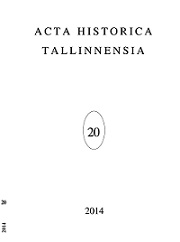ISLANDI 1783. AASTA VULKAANIPURSKE VÕIMALIKUST MÕJUST EESTIS. Keskkonnaajalooline arutlus
THE POSSIBLE EFFECT OF THE 1783 ICELANDIC VOLCANO ERUPTION IN ESTONIA. ENVIRONMENTAL CONTEMPLATION
Author(s): Priit RaudkiviSubject(s): History
Published by: Teaduste Akadeemia Kirjastus
Keywords: Estonia; Estonian History; POSSIBLE EFFECT OF THE 1783 ; ICELANDIC VOLCANO ERUPTION ; ESTONIA ENVIRONMENTAL CONTEMPLATION
Summary/Abstract: The present article seeks to answer the question whether the 1783 Laki volcano eruption had an impact in Estonia. There are no daily descriptions of gas pollution (dry fog, damaged flora, human health problems etc.) because there were no periodicals here. However, if we read a book by Jakob Benjamin Fischer published in 1791, it becomes evident that the eastern shore of the Baltic Sea was not spared. In his general account on the local natural conditions, there are a few pages dedicated to the weird weather the locals had to face in 1783. In Fischer’s account we learn of the same weather anomaly as one can find on the pages of Swedish, Dutch and English periodicals: it was hot, foggy and cloudy throughout the summer, flora was damaged, sulfur smell was in the air. But the scholar does not give a hint whether the weather anomaly had any impact on human health. The only way to find out the possible consequences of the gas attack on human health is to follow whether death rates of the year 1783 are in correlation with other countries. Fortunately, we have seasonal death rates of 54 congregations in France and 13 congregations in England. In both cases seasonal death rates of 1782 and 1784 are given for comparison. In this article the same pattern was used. On the basis of death registers seasonal mortality of 11 Estonian parishes was calculated. In some Estonian congregations the results correlate with those of France and England. Mortality was high in the summer of 1783 and low in the previous and following years. In some cases (parishes of Otepää and Kambja in the southern part of Estonia) summer death rates are especially high. The only difference is that high mortality is registered in Estonia already in June but in France and England massive deaths are recorded from August. The deviation is difficult to explain because we do not know the causes of death in Estonia. At the same time there is no reason to doubt that the unusual weather conditions (high temperature and gas pollution) triggered physiological stress, which resulted in mortality much higher than normal.
Journal: Acta Historica Tallinnensia
- Issue Year: 2014
- Issue No: 20
- Page Range: 051-073
- Page Count: 23
- Language: Estonian

